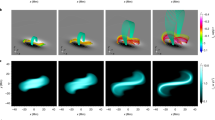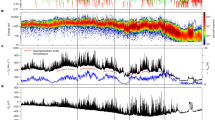Abstract
Interaction of convection with a magnetic field leads to an intermittent distribution of magnetic flux1. Such a process operating on the solar surface can lead to ‘equipartition’ fields of 700 G (ref. 2). These fields are further prone to a convective instability and eventually collapse to kilogauss intensity3–5. I show here that radiative diffusion can inhibit this collapse to a varying degree, depending on the field strength and the thickness of the flux elements. As a consequence, one would expect the field strength of the photospheric magnetic flux elements to depend on their sizes. It is shown that at one end of such a distribution there would be kilogauss tubes with small dispersion in field strength and large dispersion in size. At the other extreme of the spectrum would be thin tubes of fairly constant size but with a wide range in field strength, from kilogauss intensities to the equipartition values of 700 G. High-resolution observations from space-borne telescopes should reveal the existence of the latter variety of tubes.
This is a preview of subscription content, access via your institution
Access options
Subscribe to this journal
Receive 51 print issues and online access
$199.00 per year
only $3.90 per issue
Buy this article
- Purchase on Springer Link
- Instant access to full article PDF
Prices may be subject to local taxes which are calculated during checkout
Similar content being viewed by others
References
Proctor, M. R. E. & Weiss, N. O. Rep. Prog. Phys. 45, 1317–1379 (1982).
Parker, E. N. Cosmical Magnetic Fields, 268 (Clarendon, Oxford, 1979).
Webb, A. R. & Roberts, B. Sol. Phys. 59, 249–274 (1978).
Spruit, H. C. & Zweibel, E. G. Sol. Phys. 62, 15–22 (1979).
Unno, W. & Ando, H. Geophys. astrophys. Fluid Dyn. 12, 107–115 (1979).
Roberts, B. & Webb, A. R. Sol. Phys. 56, 5–35 (1978).
Webb, A. R. & Roberts, B. Sol. Phys. 68, 87–102 (1980).
Venkatakrishnan, P. J. Astrophys. Astr. 6, 21–34 (1985).
Venkatakrishnan, P. in Proc. MPA/ LPARL Workshop theor. Probl. high-resol. Sol. Phys. (ed Schmidt, H. U.) 200–203 (Max-Plank-Institute für Physik und Astrophysik, Garching, 1985).
Schmidt, H. U., Simon, G. W. & Weiss, N. O. Astr. Astrophys. 148, 191–206 (1985).
Nordlund, A. in Proc. MPA/LPARL Workshop theor. Probl. high-resol. sol. Phys. (ed. Schmidt, H. U.) 101–123 (Max-Plank-Institute fü Physik und Astrophysik, Garching, 1985).
Muller, R. Sol. Phys. 52, 249–262 (1977).
Spruit, H. C. thesis, Univ. Utrecht (1977).
Spruit, H. C. & Zwaan, C. Sol. Phys. 70, 207–228 (1981).
Hasan, S. S. Mon. Not. R. astr. Soc. 219, 357–372 (1986).
Author information
Authors and Affiliations
Rights and permissions
About this article
Cite this article
Venkatakrishnan, P. Inhibition of convective collapse of solar magnetic flux tubes by radiative diffusion. Nature 322, 156–157 (1986). https://doi.org/10.1038/322156a0
Received:
Accepted:
Issue Date:
DOI: https://doi.org/10.1038/322156a0
This article is cited by
-
Critical Science Plan for the Daniel K. Inouye Solar Telescope (DKIST)
Solar Physics (2021)
-
Solar Magnetoconvection and Small-Scale Dynamo
Space Science Reviews (2017)
-
The magnetic field in the solar atmosphere
The Astronomy and Astrophysics Review (2014)
-
Small-Scale Solar Magnetic Fields
Space Science Reviews (2009)
-
Solar magnetic fields
Journal of Astrophysics and Astronomy (2008)
Comments
By submitting a comment you agree to abide by our Terms and Community Guidelines. If you find something abusive or that does not comply with our terms or guidelines please flag it as inappropriate.



